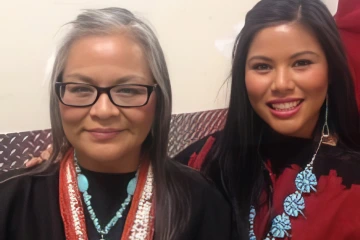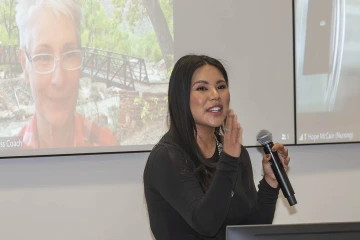Dr. Timian Godfrey draws on tradition for guidance, strength
Following the Navajo philosophy of interconnectedness between physical, spiritual well-being and the world led Dr. Godfrey to a career in nursing education.

Timian Godfrey, DNP, APRN, FNP-BC, meets with students taking part in the annual summer Arizona Nursing Career Apex Transitions program and summer intensive at the University of Arizona College of Nursing.
It’s hard not to be drawn to Timian Godfrey, DNP, APRN, FNP-BC, an assistant clinical professor at the University of Arizona College of Nursing. She has a warm, welcoming smile and easy laugh. There is passion in her voice as she talks about creating equitable opportunities in nursing for students from historically marginalized communities. She is also open about discussing how important failure was on her path to becoming who she is today.
But what really sets Dr. Godfrey apart is Hózhó.

Timian Godfrey, DNP, APRN, FNP-BC, said that coming to the University of Arizona College of Nursing allowed her to “pursue my passions in education, research, and policy with tribal communities. I love it here. I really feel a sense of belonging.”
“As a Navajo woman, the traditional belief of Hózhó is deeply rooted in who I am,” Dr. Godfrey explained. “Hózhó is a complex, holistic philosophy of interconnectedness between health and well-being resulting in physical and spiritual beauty, harmony and goodness. This highly valued belief guided my decision to choose a career in nursing.”
Dr. Godfrey was born in Provo, Utah and grew up 30 miles south of Salt Lake City, Utah in American Fork. Her mother is Diné (Navajo) from Crystal and Shiprock, New Mexico, and her father is Okinawan-Hawaiian, from Oahu, Hawaii. She grew up taking part in Native American singing and dancing groups and learning Hula and Hawaiian songs.
“At home we had a lot of cultural connections as part of our daily lives, but outside of home I felt different. I did not fit in,” Dr. Godfrey said. It was the summers she spent on the Navajo Nation in New Mexico with her aunts, uncles and cousins that deepened her connection to Hózhó, leading her down the path towards nursing and higher education.
Dr. Godfrey, who teaches in the college’s Doctor of Nursing Practice program family nurse practitioner specialty, became a certified nursing assistant at 16. After “barely graduating high school,” she worked as a CNA for two years where she recognized the tremendous potential nurses have on improving health and wellness in people, their families and communities.

Dr. Godfrey with her mom, Bernice Francisco Yoshimoto, at a traditional performance in Las Vegas, Nevada.
When Dr. Godfrey earned her Bachelor of Science in Nursing from Southern Utah University, her experience with academia was still challenging for her.
“I struggled as an undergrad as I was working full time as a CNA and EMT,” Dr. Godfrey said. “Meeting mentors made all the difference. As a society we put so much emphasis on GPA, but what is just as valuable are people who are hardworking, innovative and compassionate. That doesn’t always correlate with GPA. We must be adaptable to individuals and their learning styles to educate a dynamic future health care workforce ready to meet the multifaceted needs of an evolving society.”
Still in school
Dr. Godfrey earned her Master of Science Nurse Practitioner degree from the University of Nevada, Las Vegas, then her Doctor of Nursing Practice-Executive Leadership degree from Johns Hopkins before joining the UArizona College of Nursing faculty in 2019. Currently, she is enrolled in a nursing and health innovation PhD program through Arizona State University’s Edson College of Nursing and Health Innovation.
“I’m really surprised that I’m still in school,” said Dr. Godfrey. “When I was younger, I thought my career would be more settled at this point in my life. The reality is though, more so than at any time in my life, I am acutely aware of how much I do not know and how much more I need to learn, which is why I am pursuing a PhD.”
While at Johns Hopkins she received a scholarship through the Bloomberg School of Public Health to receive public health training and certification in American Indian Health. “Prior to this, I had no intention of working in academia. However, these research and education experiences opened my eyes to the impact population health focused work in policy and research can have on health inequities for Indigenous Peoples.”
Dr. Godfrey decided to pursue a research doctorate to build on her practical experience. “I wanted a stronger skill set in how to generate evidence,” she said “I want to be able to take what I know and conduct research that generates evidence to support health equity for all people, but particularly Native communities. There is a lack of indigenous-led community generated research. This is a promising approach that can lead to positive outcomes.”
Arizona is home
The interconnectedness of Hózhó brought Dr. Godfrey to the university. Her husband Brandon Godfrey, MD, matched with University of Arizona College of Medicine – Tucson for a residency in emergency medicine.

Dr. Godfrey is the project director for the nursing workforce diversity initiative at the College of Nursing.
At the College of Nursing, Dr. Godfrey is the principal investigator for two federal grants aiming to diversify the nursing workforce and increase the presence of Native American nurses working in tribal communities.
“Timian shows an enviable balance of being personally persuasive about her ideas, while inviting and incorporating the ideas of all present,” said Joan L. Shaver, PhD, RN, FAAN, professor and former dean of the College of Nursing. “Timian shows herself to be a generous and skillful mentor for colleagues and students.”
She is also collaborating with colleagues to increase equity, diversity and inclusion initiatives at the College of Nursing and formally institutionalize EDI efforts. She is the project director for the nursing workforce diversity initiative at the college.
“Timian is a joy to work with,” said Francine C. Gachupin, PhD, MPH, associate professor at the UArizona College of Medicine – Tucson. “Timian is very committed and dedicated to becoming a responsive and respectful community-based participatory researcher. She cares about the individuals impacted by illness and is invested in making their condition better while employing scientific rigor in her approaches.”
Empowered by students
The mother of two girls, 8 and 5-years-old, admits she has a lot on her plate, but says she is buoyed by her colleagues and inspired by her students and the communities she works with.

Dr. Godfrey with her husband, Brandon Godfrey, MD, and their two daughters in 2019 after her DNP commencement.
Dr. Godfrey said that she was taught to work hard, keep her head down and not to draw attention to herself. “I think that made me more passive and accepting, but students today challenge the norms,” she said. “The students we have now want to know the reasons behind certain policies and seek to understand the decision-making process. They challenge me to know the why behind what I am teaching. It challenges me to do more research. I find it empowering.”
Dr. Godfrey draws on the challenges, including failures, she faced as a student in high school and as an undergraduate to connect with and support students, especially those who come from underrepresented in nursing communities. “I fail all the time and I have to be transparent with team members and students,” she said. “Failing is essential to growth. Don’t let the fear of failure stop you from doing something.”
Walk in beauty
With Hózhó guiding her, Dr. Godfrey is fueled by the strength of universal connections to provide opportunities to underrepresented people in health care education and to promote inclusive policies.
“We are all connected to each other — the Earth, the animals, the sky and sun. That harmony between all these things is what keeps us healthy,” Dr. Godfrey said. “I truly believe if we put out beauty, harmony and goodness, it permeates throughout our world.”
Dr. Godfrey said there is a saying in Navajo that is used when saying goodbye that sums up the Hózhó philosophy she strives to follow: “May you walk in beauty.”

